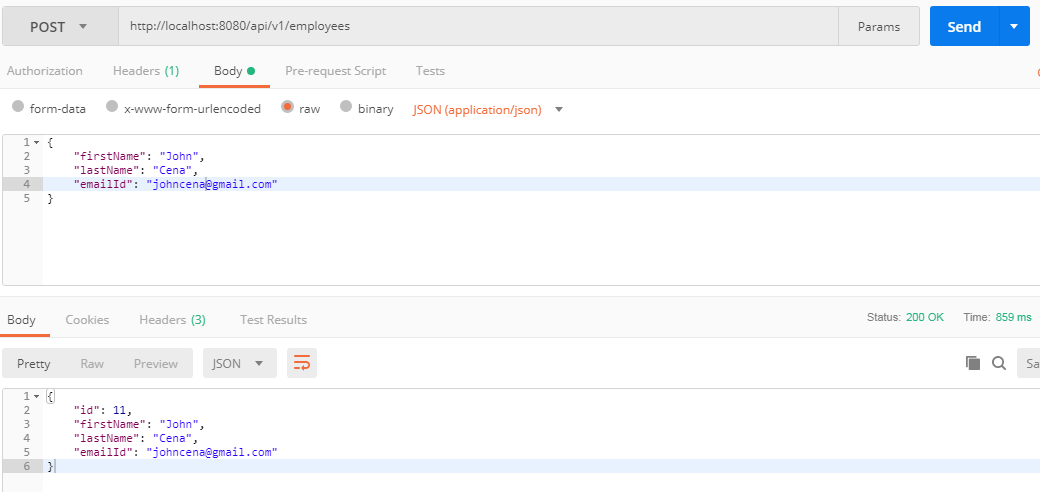🎓 Top 15 Udemy Courses (80-90% Discount): My Udemy Courses - Ramesh Fadatare — All my Udemy courses are real-time and project oriented courses.
▶️ Subscribe to My YouTube Channel (178K+ subscribers): Java Guides on YouTube
▶️ For AI, ChatGPT, Web, Tech, and Generative AI, subscribe to another channel: Ramesh Fadatare on YouTube
In this quick article, we will discuss the usage of Spring @RequestBody and @ResponseBody annotations with examples.
@RequestBody and @ResponseBody annotations are used to bind the HTTP request/response body with a domain object in the method parameter or return type. Behind the scenes, these annotation uses HTTP Message converters to convert the body of HTTP request/response to domain objects.
YouTube Video
@RequestBody and @ResponseBody annotations are used to bind the HTTP request/response body with a domain object in the method parameter or return type. Behind the scenes, these annotation uses HTTP Message converters to convert the body of HTTP request/response to domain objects.
@RequestBody Annotation
Annotation indicating a method parameter should be bound to the body of the web request. The body of the request is passed through an HttpMessageConverter to resolve the method argument depending on the content type of the request. Optionally, automatic validation can be applied by annotating the argument with @Valid.
First, let’s have a look at a Spring controller method: In the below example, the employee JSON object is converted into a Java employee object using @RequestBody annotation.
Spring automatically deserializes the JSON into a Java type assuming an appropriate one is specified. By default, the type we annotate with the @RequestBody annotation must correspond to the JSON sent from our client-side controller:
@ResponseBody Annotation
When you use the @ResponseBody annotation on a method, Spring converts the return value and writes it to the HTTP response automatically. Each method in the Controller class must be annotated with @ResponseBody.
Behind the Scenes
Spring has a list of HttpMessageConverters registered in the background. The responsibility of the HTTPMessageConverter is to convert the request body to a specific class and back to the response body again, depending on a predefined mime type. Every time an issued request hits @ResponseBody, Spring loops through all registered HTTPMessageConverters seeking the first that fits the given mime type and class and then uses it for the actual conversion.
The @ResponseBody annotation tells a controller that the object returned is automatically serialized into JSON and passed back into the HttpResponse object.
Suppose we have a custom Response object:
Next, the associated controller can be implemented:
In the developer console of our browser or using a tool like Postman, we can see the following response:
@RestController Annotation
Spring 4.0 introduced @RestController, a specialized version of the controller which is a convenience annotation that does nothing more than adding the @Controller and @ResponseBody annotations.
By annotating the controller class with @RestController annotation, you no longer need to add @ResponseBody to all the request mapping methods. The @ResponseBody annotation is active by default.
To know about @Controller and @RestController annotation in-detail at The Spring @Controller and @RestController Annotations with Examples
Related Spring and Spring Boot Annotations
- Spring Boot @Bean Annotation Example
- Spring @Qualifier Annotation Example
- Spring @Autowired Annotation with Example
- Spring @Bean Annotation with Example
- Spring @Configuration Annotation with Example
- Spring @PropertySource Annotation with Example
- Spring @Import Annotation with Example
- Spring @ImportResource Annotation Example
- Spring - @Lazy Annotation Example
- Spring - @Primary Annotation Example
- Spring @PostConstruct and @PreDestroy Example
- Spring @Repository Annotation
- Spring @Service Annotation
- The Spring @Controller and @RestController Annotations
- Spring Boot @Component, @Controller, @Repository and @Service
- Spring @Scope annotation with Prototype Scope Example
- Spring @Scope annotation with Singleton Scope Example
- Spring Boot @PathVariable
- Spring Boot @ResponseBody
- Spring @RequestBody - Binding Method Parameters to Request Body
- Spring Boot @ResponseStatus Annotation
- Spring Boot - Creating Asynchronous Methods using @Async Annotation
- @SpringBootTest Spring Boot Example
- @SpringBootTest vs @WebMvcTest
- @DataJpaTest Spring Boot Example
- Spring @PostConstruct and @PreDestroy Example
- Spring @GetMapping, @PostMapping, @PutMapping, @DeleteMapping and @PatchMapping
- Spring Boot @EnableAutoConfiguration Annotation with Example
- Spring Boot @SpringBootApplication Annotation with Example




![[NEW] Full-Stack Java Development with Spring Boot 4 & React Build 5 Spring Boot Projects with Java: Line-by-Line Coding](https://img-c.udemycdn.com/course/750x422/5338984_4d3a_5.jpg)















Comments
Post a Comment
Leave Comment